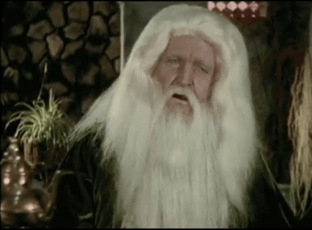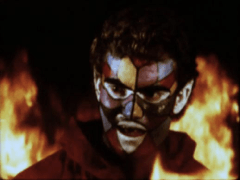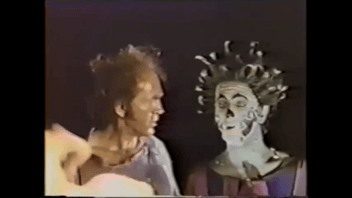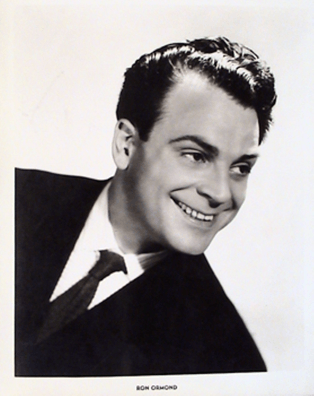Today, we’re super excited to have a guest post authored by the mind behind Vacation Bible School, the YouTube channel, blog, and podcast devoted to the nostalgia of middle-America evangelicism from the 80s and 90s. I’m a huge personal fan of vaporwave, an obscurish form of nostalgic electronic music, and if you happened to also grow up in flyover country, you might experience a flash of nostalgia like I did. Not only has VBS done an incredible job in compiling this footage, but a lot of intensive research on Ron Ormond, producer of low-budget Christian films. It’s a bizarre story. – Gil
Ron Ormond
Ron Ormond was a director of cheap exploitation and grindhouse films who converted to Christianity. He then took his directorial style and made cheap Christian propaganda films full of gore and terror — thus coining the term “Christploitation.”
Ron Ormond (1910-1981) was born in Baldwin, Louisiana. He started his career in showbiz as a vaudevillian-styled entertainer hosting performances and doing magic tricks, which is how he met his wife, June.
As a filmmaker and director, Ormond was typically entrenched in psychotronic films and B-Movies. Psychotronic is a term “denoting or relating to a genre of movies, typically with a science fiction, horror, or fantasy theme, that were made on a low budget or poorly received by critics.” These types of productions “can commonly be identified by their use of exploitation elements and their interest in humanity’s lower common denominators.”
Ormond ended up establishing himself as one of the top (and only) filmmakers operating in Nashville, Tennessee. This allowed him to have access to more resources than other exploitation filmmakers of his kind because he was basically the only fish in the pond. His films spanned across several genres, such as B-Movie Westerns, race car films, country music films, and good old fashion horror-exploitation. The titles of his films ought to tell you everything you need to know: Fast on the Draw (1950), King of the Bullwhip (1950), Kentucky Jubilee (1951), The Thundering Trail (1951), Yes Sir, Mr. Bones (1951), The Vanishing Outpost (1951), The Black Lash (1952), The Frontier Phantom (1952), Outlaw Women (1952), Naked Gun (1956), The Black Panther (1956), Please Don’t Touch Me (1963), Forty Acre Feud (1965), Girl from Tobacco Row (1966), White Lightnin’ Road (1967), The Exotic Ones aka The Monster and the Stripper (1968).
Ormond was known as a great marketer of schlock and sleaze. Legend has it that, for his film Untamed Mistress, Ormond basically promised scenes of bestiality between gorillas and a female version of Tarzan (and some claim that this film depicts overt racist messages). Amongst film producers of this era, he was known for his ability to accomplish film projects on extremely low budget constraints. Despite what limitations producers threw at him, Ormond was often able to generate a profit – a skill that would be of great help for him in later days.
During his ‘secular’ era, Ormond was the creative mind and director behind a film project called Mesa of a Lost Woman. This went on to become one of his most ‘famous’ (I use this term very loosely) secular films. Producers asked Ormond to stitch together a movie using scrapped and leftover footage from a previously failed production. The result is a crazy, psychotronic sci-fi escapade of women being transformed into hybrid-spider monsters as someone strums a guitar as fast as possible for (what feels like) the entire movie. To top things off, the mad scientist of the film is played by Jackie Coogan (the Uncle in the Addams Family).
His other most popular non-religious film was called The Exotic Ones or, alternatively, The Monster and the Stripper. The plot follows a team of hunters who find a humanoid beast in the swamp called “The Swamp Thing” (no connection to the DC Comics). It involves strippers (of course), but also killing a real chicken (which is terrible; you shouldn’t kill animals for entertainment). The most famous scene is when the Swamp Thing beats a man to death with a severed arm. To make things even crazier, this was filmed in a studio owned by a Methodist Church. 
In addition to his filmmaking, Ron Ormond also worked on the topic of hypnosis with author and friend Ormond McGill. Two of their books — Religious Mysteries of the Orient and Into the Strange Unknown — can be priced up to 5,000 dollars! In my humble opinion, no book should be worth that much unless Shakespeare himself signs it. But apparently, they are extremely rare. I searched around for a pdf copy but couldn’t find one.
Religious Conversion of Ormond
Though he was often known as a ‘sleazemeister,’ Ormond dropped his lewd themes after a couple of freak incidents. The Ormond family – Ron, his wife June Carr, and their son, Tim – were flying their private airplane to a showing of one of their latest movies. Unfortunately, they ended up in a serious accident, where both Ron and June were injured (Tim emerged unscathed). Within a few years, they had a new airplane, but that one also crashed!
The Ormond family took this as a kind of spiritual ‘wake up call.’ Rather than using their resources to make films about monsters killing strippers, they ought to make movies that glorify God. Soon, they were put into contact with a fire-and-brimstone preacher named Estus Pirkle.
Pirkle was quite concerned about the possibility of communists taking over the United States. Mind you, this was during the middle of the Cold War, and so many people were concerned about this as well. However, Pirkle was convinced that, unless America adopted his own fundamentalist brand of Christianity, communists were certain to overthrow America and begin a mass genocide of all Christians. The Baptist preacher was also obsessed with his peculiar doctrine of hell, and wanted to let people know that they were probably going to end up there someday.
As fate would have it, the exploitation director collided with the fire-and-brimstone preacher, and the two of them decided to work on a film together. And thus was born the first Christploitation cinema classic: If Footmen Tire You, What Will Horses Do? (1971)
 Footmen has been described as “the most confounding piece of homegrown budget-consciousness surrealism ever filmed”. The film transitions back and forth between a sermon presented by Pirkle and dramatizations filmed by Ormond. However, these dramatizations feature gruesome scenes depicting imagined communist torture techniques, murder, and future horrors of Christian persecution. By combining psychotronic film with religious propaganda and gory fear-mongering, this movie claims that youth culture is destroying the Christian values at the heart of American freedom. This, according to Pirkle, opens America to the threat of a communist takeover, which would be a near-apocalyptic event. The film’s message to non-Christians is that they need to convert to Christianity. To audience members who already believed, the film was meant to inspire them to reflect about whether or not they took their faith seriously, and if they could withstand possible persecution or eschatological horrors. Thus, “Footmen” refers to the threat of communism, and “Horsemen” refers to the biblical imagery of the four horsemen of the apocalypse. These two threats are coming to get you.
Footmen has been described as “the most confounding piece of homegrown budget-consciousness surrealism ever filmed”. The film transitions back and forth between a sermon presented by Pirkle and dramatizations filmed by Ormond. However, these dramatizations feature gruesome scenes depicting imagined communist torture techniques, murder, and future horrors of Christian persecution. By combining psychotronic film with religious propaganda and gory fear-mongering, this movie claims that youth culture is destroying the Christian values at the heart of American freedom. This, according to Pirkle, opens America to the threat of a communist takeover, which would be a near-apocalyptic event. The film’s message to non-Christians is that they need to convert to Christianity. To audience members who already believed, the film was meant to inspire them to reflect about whether or not they took their faith seriously, and if they could withstand possible persecution or eschatological horrors. Thus, “Footmen” refers to the threat of communism, and “Horsemen” refers to the biblical imagery of the four horsemen of the apocalypse. These two threats are coming to get you.
One of the most ‘fascinating’ aspects of this movie is, first of all, how the communists take over. They are presented as simply riding their horses into America and taking over the country with hardly any struggle. Why is this possible? The answer was already hinted at above: the sins of the youth. But what are these sins that will lead us straight into a nation-wide communist control? Watching television, sex-ED classes in school, going to drive-in theaters, and dancing. So next time you are doing the ‘cha-cha slide,’ remember that you’re pushing us all one step closer to the gulag.
 The other unexpectedly horrific aspect of this movie is the violence and torture it depicts toward children. One child gets his head chopped off, while others are gunned down. But the most gruesome scene (in my opinion) is when they impale a long nail through a little boy’s ears so he will ‘no longer be able to hear the word of God.’ The boy then vomits everywhere.
The other unexpectedly horrific aspect of this movie is the violence and torture it depicts toward children. One child gets his head chopped off, while others are gunned down. But the most gruesome scene (in my opinion) is when they impale a long nail through a little boy’s ears so he will ‘no longer be able to hear the word of God.’ The boy then vomits everywhere.
The second film Ormond made with Pirkle is The Burning Hell (1974). With the same directing format as Footmen, this film features another gory entry into the Christploitation genre. Pirkle’s fire-and-brimstone fear-mongering is taken to new heights as Ormond’s grindhouse style of directing brings imaginations of Hell onto the screen in bloody display.
 While still being a sermon and pseudo-‘education’ film, The Burning Hell contains more narrative elements than its predecessor. These include the worst biblical reenactments of all time. In one of these reenactments, Moses (who looks like Santa) opens up the gates of hell, and it swallows people almost like the Sarlacc pit. In another scene, Cain kills his brother Abel by hitting him with a large club in a manner that looks like something from The Three Stooges. Cain then chokes Abel to death, so it’s as if an episode of The Three Stooges turned into cold-blooded murder. The overarching narrative that connects all the individual elements of the movie follows two young men. They are ‘bad boys’ and hippies who are terrible Christians because they believe that God is loving enough to let lots of people into heaven. One of them dies and is sent to hell. The other ends up converting to Christianity so he doesn’t end up like his friend.
While still being a sermon and pseudo-‘education’ film, The Burning Hell contains more narrative elements than its predecessor. These include the worst biblical reenactments of all time. In one of these reenactments, Moses (who looks like Santa) opens up the gates of hell, and it swallows people almost like the Sarlacc pit. In another scene, Cain kills his brother Abel by hitting him with a large club in a manner that looks like something from The Three Stooges. Cain then chokes Abel to death, so it’s as if an episode of The Three Stooges turned into cold-blooded murder. The overarching narrative that connects all the individual elements of the movie follows two young men. They are ‘bad boys’ and hippies who are terrible Christians because they believe that God is loving enough to let lots of people into heaven. One of them dies and is sent to hell. The other ends up converting to Christianity so he doesn’t end up like his friend.
My favorite part of this entire movie is actually one of the demons in hell. He is wearing what looks like a devil costume from the dollar store. But the coolest part is that he has this awesome face makeup that looks like the design for a deck of cards at a fancy casino. His entrance is like something from a GQ fashion shoot from hell. Admittedly, he has little to do with the plot of the movie. I just like showing it to people whenever I discuss this film because we could all use more GQ casino devils in our lives. (You can find his full scene on my YouTube page. The video is titled “The Most Fabulous Demon in Hell.”)
After some ‘artistic’ disagreements (actually, I hear it was about money), Pirkle and Ormond parted ways. Ormond went on to write, produce, and direct his own Christploitation film, titled The Grim Reaper. At this point, I’ll have to divulge a hot-take for you: The Grim Reaper is my favorite Christploitation film. Some reviews I’ve read online believe that the absence of Pirkle’s outrageous preaching weakens the movie, but I think that’s its biggest strength. Though the sheer insanity of Pirkle’s preaching style is worthy of guffaw, I enjoyed The Grim Reaper’s focus on narrative. I personally get tired of Pirkle yelling at me after some time, and I just want to watch some poorly-acted B-Movie horror. There are a few moments of preaching in The Grim Reaper, but they take a backseat to a far more interesting occult story about demons.
A young adrenaline junky dies in a car race after refusing to believe in Christianity. He is then sent to hell. The narrative then follows the rest of the family – the mother, brother, and father – as they deal with the loss. The mother and brother are both Christians, but the father is not. In an attempt to contact his dead son, the father seeks the guidance of a spirit medium, who is actually possessed by a demon, and conjures up all sorts of demonic spirits. The movie then teaches that demons are around us at all times, hoping to ensnare us. Eventually, the father recognizes his need to gain full resistance to satanic forces, and thus converts to Christianity.
There are some ‘great’ scenes in this movie. My personal favorite is when the spirit-medium conjures up demonic spirits during a séance. I thought this was a great directorial move. By introducing spiritualism, occultism, and the demonic into the equation, the product is a Christploitation film with more horror elements rather than only Baptist propaganda. The medium summons the spirits of various departed individuals, and we are treated to an eerie display of ghostly figures appearing in the room while reality itself seems distorted and surreal. This is actually a wonderfully fun display of B-Movie film-making.
We also learn during his ritual that the medium is possessed by a demon, which is why he is able to summon these spirits. This is depicted by occasionally cutting for just a half-second to a red-faced devil and then back to the medium. It looks like a dollar-store Halloween costume version of the demon in the first Insidious movie.
Though this isn’t the only outrageous scene. We are treated to more terrible reenactments of biblical stories – including a returning appearance of Santa Moses from The Burning Hell. Furthermore, the movie features an extended scene in where the father receives a vision of his possible future in hell. This is my favorite ‘hell scene’ Ron Ormond ever directed, and that includes the scenes from The Burning Hell. The guiding ‘Virgil’ of this trip to Hell is a zombie-like corpse who looks kinda like Marv in the electrocution scene from Home Alone 2. The other characters shown in this psychotronic hellscape are just as crazy — specifically the costumes. It’s exactly what you’d expect if you took the mind of an exploitation film director and merged it with Halloween costumes from a thrift store. I’m 99% certain that there is even someone just wearing an un-altered Dracula costume. However, the most unsettling character looks like the offspring of Pennywise and Legolas. It’s as if someone gave her a papier-mâché forehead and elf ears without ever painting them. The ‘hell vision’ ends with the father’s ghostly spirit spiraling over an erupting volcano. (And I’m filled with joy that I had the opportunity to actually type out that sentence.)
Ormond and Pirkle eventually reunited again for the third entry into the psychotronic exploitation religious trilogy. The Believer’s Heaven was released in 1977 and, like most final chapters in a trilogy, it was the least well received in the series. The goal of the trilogy was to take people from earthly persecution, through the threatening torments of hell, and finally to a heavenly hope.
 Admittedly, I have not scene the full movie because it’s extremely difficult to find a copy. However, I found a few short clips online, and even a review from Cinema Snob on YouTube. Now, given that the topic is about heaven, I’m sure most of us would probably expect the movie to contain a boring, stereotypical portrayal of the afterlife according to the common tropes in our culture. We are wrong.
Admittedly, I have not scene the full movie because it’s extremely difficult to find a copy. However, I found a few short clips online, and even a review from Cinema Snob on YouTube. Now, given that the topic is about heaven, I’m sure most of us would probably expect the movie to contain a boring, stereotypical portrayal of the afterlife according to the common tropes in our culture. We are wrong.
Estus Pirkle has changed his preaching style, and now moves around the stage like an android trying to fool you into thinking he’s human. They also got ‘creative’ and included segments of Estus in front of a green screen with strange, trippy backgrounds. Other scenes include swelling psychedelic glitter spectacles that engulf the whole screen like a kaleidoscope. We are also treated to a few biblical reenactments – a staple of Ormond’s movies. This includes a return of Santa Moses, who now looks like Merlin from King Arthur literature or perhaps the giant bearded head from The Land of Faraway.
Of course, given that this is an Ormond film, they had to play the hits, which include more depictions of hell, and a scene where the dead bodies of children are thrown into a mass grave (or something like that). However, the most insane feature of this movie is how they chose to depict the concept of heaven being free from physical infirmity or deformities. They chose to film people with actual deformities and illnesses, while talking about how these individuals will be finally cured once they die. Ormond and Pirkle even make these people sing and perform in front of the congregation! They make a woman with a kind of dwarfism sing a gospel song, and they make a group of diseased and deformed children sing a hymn (when they obviously don’t want to). This reaches new heights of Christploitation that I never dreamed of. We moved beyond the simple fear-mongering of a radical religious fundamentalist and into the realm of exploiting disabled people for profit. Though it claims to be a Christian movie, this is profoundly not Christlike. 
The last film Ormond ever directed in called 39 Stripes. This film is the least exploitative of his Christian filmmaking era. It is based on the true story of Ed Martin, a criminal who converted to Christianity while in prison, and then started his own prison ministry. After directing this film, Ron Ormond became sick, and didn’t have the energy to direct again. The last movie he had influence on was The Second Coming – an apocalyptic film about the rapture similar to Left Behind. Ron’s son, Tim, wrote the script, and Ron provided advice during the process. I wish I could provide more information on it, but it is even more difficult to find than The Believer’s Heaven. Unfortunately, Ron passed away in 1981 before the film was produced. He was 70 years old.
Concluding Thoughts on Ron Ormond
I feel obliged to say that I neither support nor condone the Ormond films and how they use fear-mongering tactics to promote religion. I feel genuine empathy and sadness for the people who had to sit through a screening of one of these films, and might have been frightened to death. However, the fact that someone made grindhouse-style Christian movies in the late-70s era of psychotronic films is flabbergasting. Such a state of affairs rarely occurs, but when it does, the results are terribly legendary.
What do you think? Is there any artistic value to these movies beyond exploitation? Have you had any experience with these films? Are the Ormond/Pirkle movies simply propaganda, or is there more depth to them than one might initially think?
Thank you so much to Cult Celebrities for allowing me to write a guest post. Best wishes to you all.
Sincerely,
Vacation Bible School.
If you want to keep up more with my work, you can find me at my blog!
My podcast: “Churchwave Radio” (it’s available on most podcast platforms, including Apple and Spotify).
My YouTube channel: “Vacation Bible School”
Facebook: “Churchwave,” Twitter: @VBS_Official, Instagram: churchwave_vbs
Gil has a bachelor’s in communication, and attended film school in Los Angeles. He worked in film & media production for several years, traveling to over 45 countries, before cofounding a marketing company. Obsessed with feel-good 80s teen comedies, sword-and-sorcery films, and gritty sci fi noir, Gildner is a fan of the weird and campy. His favorite films include Blade Runner, Alien, Mad Max, and Drive.

For anyone interested in the rare Ormond books mentioned in the article, a helpful commenter on Reddit posted this link to a PDF on archive.org: https://archive.org/details/HypnotismAmdMysticismOfIndiaOrmondMcGill/